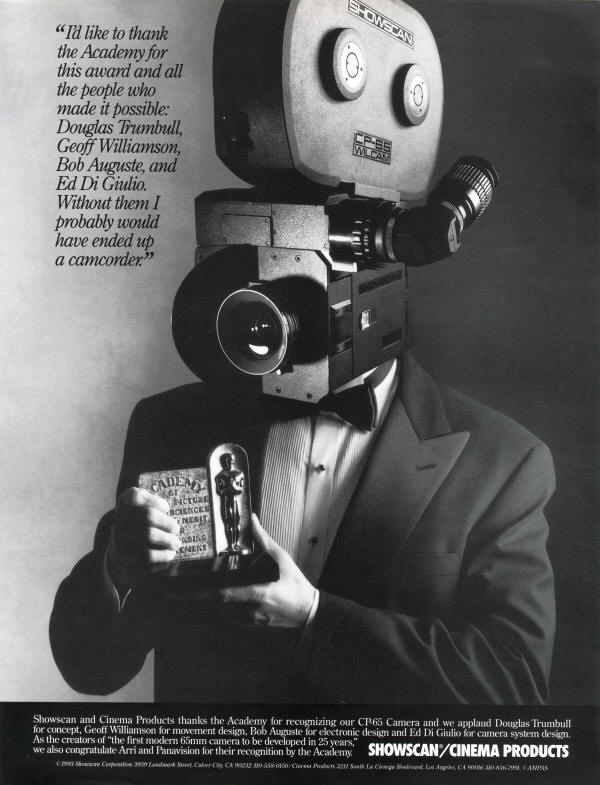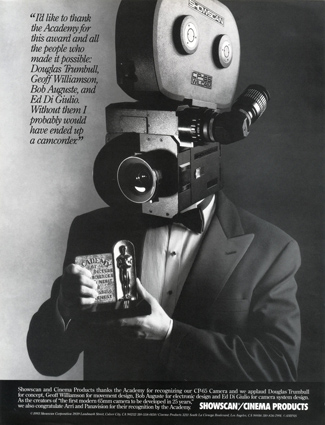Showscan enters liquidation process |
This article first appeared on in70mm.com The 70mm Newsletter |
| Written by: Greg Faris, Screen Brilliance | March 2002 |
 LOS ANGELES ; JANUARY 2002 LOS ANGELES ; JANUARY 2002SHOWSCAN ENTERS LIQUIDATION PROCESS SHOWSCAN, formerly Showscan Film Corporation has seen their chapter 11 reorganization bid transformed into a chapter 7 liquidation process, which means the company will be ordered to cease operations entirely. This result, unanticipated by those close to the company, is saddening news to SCREEN BRILLIANCE, who have worked extremely closely with Showscan since the early days of both companies, and who have participated in the development and deployment of Showscan's large screen and motion simulator processes worldwide. Many who have followed Showscan's progress through the last rocky years may not be fully aware, nor fully recognizant of the prodigious visionary aspect of its creation and early development. Developed by special effects master Douglas Trumbull ("Brainstorm", "2001 Space Odyssey"), the patented film origination and presentation process utilized a 70mm, 5-perforation film, projected at the astonishing cadence of 60 frames per second in a quest for nothing less than the most perfect projected image possible. Those millions of spectators who have had the chance to see the Showscan process projected in a well-designed theater may count themselves among the fortunate few to have seen what may be the brightest, sharpest and perhaps most perfect image ever to grace a movie screen, past present or future. Indeed, it is highly likely, in today's world of fast-moving, wholesale image consumption, every day more greatly influenced by television pacing and packaging, that no mindspring or visionary will find inspiration in the development of an image as sumptuous as what we have been able to witness in the Showscan process. Certainly, Showscan may have paid the price of some unsuccessful management choices, however more than this they have fallen victim to a dwindling market, which we fear could be indicative of a general weakening of quality standards in the image technology market, where "nothing but the best" has become an antiquated and unsaleable business credo. In developing the Showscan process, Trumbull was following in the footsteps of Waller, Reed, Todd and others, who through Cinerama, Todd-AO and multichannel audio aspired to ever higher levels of impact and audience involvement in motion pictures. Today, when safety standards in many locations require movies to be projected with the lights on, and audiences' fingers are trembling for want of the zapper as soon as a shot exceeds three seconds in length, there is little left but nostalgia for those who have endeavored to deliver such levels of awe and showmanship in the movies. The Showscan ideal becomes one more page of nostalgia. To all our friends at Showscan, we wish the best for the future, and the fondest remembrance of the past. We've been through great times together, and more recently through less than great times, and in some way we may have paid the price of being believers - but what a glorious thing we have seen. Greg Faris Screen Brilliance |
Further in 70mm reading: "Brainstorm" in 65mm "2001: A Space Odyssey" in the presence of Douglas Trumbull |
"What happens now?" |
|
|
A few contributors have written with "What happens now?" types of questions,
regarding intellectual property, inventory liquidation, etc. I do not speak
for Showscan, nor am I concerned, even indirectly, by the liquidation process, so I would recommend directing specific questions directly to Russ
Chessley or Anita Ward - email me if you need their contact info. I can give a few generalities: The patent on the 60FPS origination and presentation process expired in 2001, at least in the US. It may still be in force in other countries, such as the European Union, who have longer-lasting patent laws. The patent does not cover filming at 60FPS (as everyone uses high frame rates for slow motion photography) nor projection at 60FPS, but only the two together - filming at 50FPS or higher for the express purpose of projection at the same frame rate. If anyone is seriously considering doing this, they could at least theoretically be restricted by intellectual property issues outside the US. There could be some miscellaneous machine patents as well, concerning certain implementation aspects of their electronic projector, or other equipment. Though some restraint is usually good advice for any would-be ambulance chasers, the truth is there is no one left to enforce these patents, which were never of the same significance as the general patent anyway. Showscan, through the course of the reorganization process, made very serious efforts to answer to the requirements of the court and the demands of their creditors, efforts which were at times contradictory. At the point of liquidation I would suspect their inventory holdings were down to a bare-bones minimum, and whatever material assets remain will be contested among the listed creditors. The most significant holding is, of course, the film library itself, including all of the titles mentioned by contributors here, and quite a few more, mostly for dynamic motion theaters. The library will certainly come to auction at a date to be determined by the court - one would suspect within the next couple of months. There could be "cure" amounts to be paid by the successful bidder, over and above the actual bid amount. Contact Russ or Anita directly for more precise and official information. Showscan license holders, wondering what to do, should keep in contact with Anita, who may be attempting to establish a support network to answer their needs. Clients with technical difficulties or who wish to modify their systems may also contact Anita, or Screen Brilliance directly. |
|
 • Go to Showscan enters liquidation process |
|
| Go: back
- top - back issues Updated 22-01-25 |
